Red Deer Breeding Biology
Deer, like all mammals, practise internal fertilization and their reproductive cycle is highly seasonal, being driven by photoperiod (i.e. how many hours of darkness the deer sees over a 24 hour period). There is a sexually quiescent period during the spring and early summer, followed by a resurgence of sexual activity as the breeding season, formally referred to as the rut, approaches.
On your marks. Get set.

Stags undergo a puberty lasting around six months, at which point testosterone secretion begins and the process of spermatogenesis (sperm production) is complete. Data from Rum suggest that most stags start puberty at about nine or ten months old and reach sexual maturity at between one and three years old (depending on conditions), the average being around 16 months; at this point, the reproductive organs will have increased roughly ten-fold from that of the six-month-old calf.
It should be mentioned that although stags are physically capable of mating by 16 months old (i.e. there are sperm in the testes), most will not do so until at least six years old, because prior to this age the stags fail to develop a set of antlers sufficiently large to challenge other males for mating rights. Additionally, studies on free-ranging Red deer on Rum have shown that most calves will not develop the conspicuous secondary sexual characteristics (i.e. a neck mane, brown winter coat etc.) until their second year of life. It seems that there is a fairly narrow range of breeding success in free-ranging deer, with data from the Rum population showing that few stags will have much mating success until they’re six or seven years old and most will fail to carry the success into their teens.
The Red stag’s year is heavily influenced by hormones: primarily the androgen testosterone. Testosterone has a considerable influence on the sexual state of the stag. Much of the pioneering work on testosterone’s impact was done by Gerald Lincoln, Fiona Guinness and Roger Short during their time in the Red Deer Research Group (RDRG). The biologists demonstrated that castration of stags at any time of the year led to the abolition of any subsequent rutting behaviour; implanting the castrates with testosterone in December lead to resumption of rutting behaviour within a couple of weeks, although no rutting behaviour was observed until the autumn if they were implanted during April or June (when the stags are in a sexual hiatus).

When the intact stags were implanted with testosterone, no changes were seen in rutting behaviour, but there was a noticeable increase in aggression. Castration or administration of testosterone also has profound impacts on the development and cleaning of the antlers such that if a male calf is castrated it will fail to develop pedicles while, if castrated as an adult, the antlers will be lost and re-grown as normal, but will never shed their velvet layer. If you implant hinds with testosterone they too will develop the pedicles from which antlers grow. More details on the influence of hormones on antler development and rutting behaviour can be found in the corresponding QAs.
The deer cast their antlers between March and May -- the precise date is dependent upon age and social rank such that older, more dominant males cast their antlers (often several weeks) before younger ones -- when increasing day length leads to a drop in their blood testosterone level. Once the antlers have been cast the deer’s testosterone levels remain low, at less than 0.1 nanograms per millilitre (abbreviated to ng/ml, with nano- meaning ‘one billionth’), throughout the spring and early summer and the stags spend their time in bachelor groups feeding and growing a new set of antlers (see antler QA and Behaviour and Sociality). The low levels of testosterone keep the stag in a reproductively quiescent state from April until June during which time the testes are regressed within the abdomen.
The Rut: fighting for the right to mate
In mid-to-late summer (usually July or August), as day length starts to decrease, the stag’s testosterone level begins to rise to its autumnal peak of around 9 ng/ml and this has profound implications for the stag. The velvet covering that has, up until now, nourished and protected the developing antlers is cast. By late-August or early September the stags undergo various physiological changes, including maturation of their testes, a doubling of neck thickness (referred to as a hypertrophy of the neck musculature) and, in most populations, the growth of a shaggy mane – they also begin emitting a strong ‘goat-like’ odour, their larynx becomes more prominent and their tongue changes shape. Simultaneously, the bachelor groups begin to break down as the stags become more aggressive to one another.

Getting into position
At this time, the stags begin to move to traditional rutting stands and start wallowing and roaring – in the Gaelic calendar, the 20th September is traditionally Bhuiridh, the ‘Day of the Roaring’ as the stags begin vocal challenges to rivals. The rut runs from late September until early November, peaking during early October, although the amount of rutting activity is heavily influenced by the weather. In his book WildGuide, Simon King wrote:
“If I had to pick a date to watch the rut, it would be around 10 October, but weather conditions make a huge difference to the amount of activity.”
Indeed, it is generally said that a hard frost precipitates roaring, while very wet weather can serve to suppress activity. Intriguingly, studies by Geoff Asher and colleagues at the Invermay Agricultural Centre in New Zealand have found that genetics can have a significant impact on the length of the breeding season. Asher and his team have demonstrated that hybrids of Cervus elaphus scoticus (the ‘native’ Red deer in Britain) and C. e. nelsoni (a wapiti) started breeding, on average, more than a week earlier than the pureblood Red deer and continued for a few days afterwards such that the overall length of the breeding cycle for the hybrids was 13 days longer than for the Red deer.
As September draws to a close, the stags move away from their summer feeding grounds on to traditional rutting grounds, called ‘stands’. Rutting stands are typically areas of nutritious grassland, which attract females who come to feed and lay down the fat to see them through the winter. The hinds move around in herds that generally consist of family members and travel about the stands at will. A single stag will ‘lay claim’ to the best quality area, which will attract the most females and he will defend both from other stags.
A given area of grassland may contain several rutting stands, each with its own group of hinds shadowed and protected by a stag – the harems may merge or split according to the will of the hinds. Indeed, contrary to appearances, it is the hinds that ‘call the shots’ and although the stags may round up any that move away from the main herd, there is little he can do to stop the hinds moving out of his stand. Fortunately for the stags, hinds seem fairly faithful to their harems and during a study aimed at assessing paternity, Josephine Pemberton and colleagues found that hinds on Rum moved comparatively little between harems visiting, on average, three males during the 11 days when they were most likely to conceive.

Overall, it seems that the hinds are better off in a harem because not only does it offer the possibility of mating with a prime stag, but it also provides them with some respite from other males; studies in the UK and Europe have demonstrated that hinds which are in harems suffer less harassment from amorous stags than those that aren’t. This may be part of the reason that hinds in Spain’s Doñana National Park move away from some prime feeding grounds to collect at mating grounds where they form harems within the stag’s territory. A stag will generally take all necessary action to maintain the harem, because the longer he holds it, the more likely he is to mate.
Despite being generally faithful to their harems, hinds do occasionally wander and the females within a harem may show a tendency to spread out across the stand. Indeed, observations by the RDRG suggest that females hang around in harems for most of the rut, but on the day they come into season they move more widely (up to 4km/2.5mi. in one instance), visiting and, in about half the cases documented, mating with nearby stags before moving back to the harem. Outside the harem, hinds become vulnerable to what biologists call “kleptogamy”, which literally means ‘stolen sex’. Stags will often roam the periphery of the stands and, if they encounter an unguarded hind or distracted male, they will attempt to mate. Consequently, where competition is intense a stag can be seen ‘herding’ hinds in his harem; chasing around trying to keep them where he can see them.
This behaviour is not as commonplace as is often believed, however, and is seldom observed outside the Scottish Highlands and some deer parks. Indeed, in his book Deer Watch, Richard Prior wrote:
“The idea of the male rounding up his females like a sheep dog comes from observations of red deer on the open hill in Scotland. This is not typical behaviour, even of red deer. It is more or less unique to the Highlands.”
The reason for the frenetic activity of hill deer, which generally isn’t seen in forest dwelling populations, is an important consequence of the environment, as we shall come to in a moment. The upshot of all this is that, if the hinds do move out of a stag’s stand into the stand of another male, or another stag tries to claim the harem, the males must decide whether to retreat or fight.
To fight or not to fight?
Red stags are large, powerful animals with antlers that can represent formidable weaponry. Consequently, although antler clashes are a familiar image of the rut -- largely because such encounters are impressive and make captivating video and photographic footage -- the decision to fight is not one that is taken lightly and there is a highly-ritualised series of behavioural interactions that happen before stags clash.
The aim of these behaviours is to prevent direct physical violence wherever possible, because violence can be costly. Indeed, early work by the RDRG on Rum demonstrated that a rutting stag will, on average, only fight with rivals five times during the three weeks of the rut. Despite this relatively low contact rate, Tim Clutton-Brock and his colleagues have estimated that roughly 5% of rutting stags receive permanent injuries -- in the form of broken bones, deep wounds, a gouged eye etc. -- and calculate a 30% chance of a stag being maimed at some point during a typical rutting run; hence, most free-ranging stags can expect to rut for only about five seasons. Interestingly, in his 1966 book Dawn, Dusk and Deer, Arthur Cadman wrote:
"It is a curious fact that during the rut a stag secretes much adrenalin, and as a result he is able to withstand a wound which at other times would prove fatal. He also bleeds much less freely."
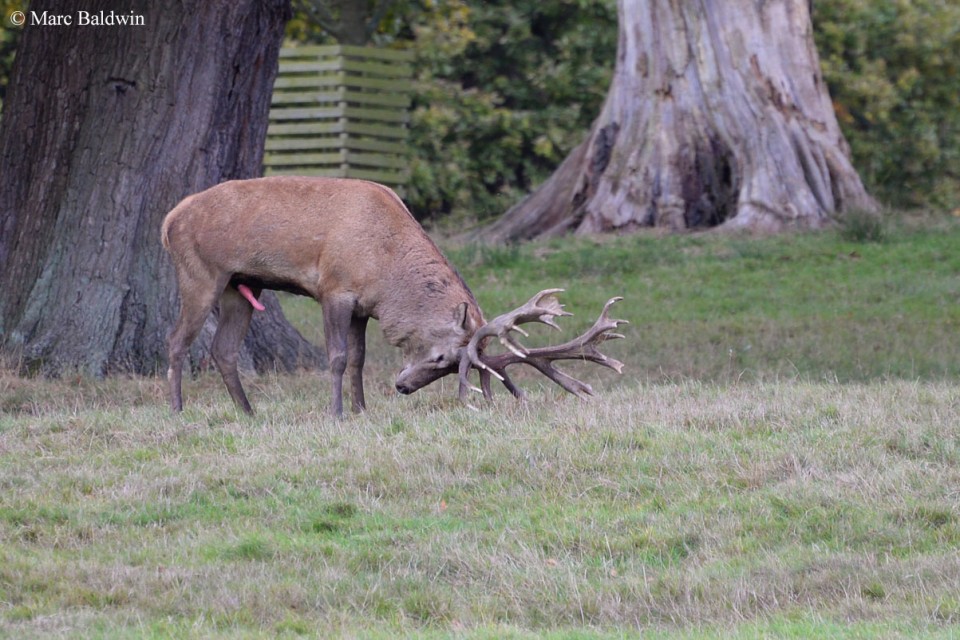
Strutting your stuff
When two harems get close, or a stag decides to try and approach another male’s harem the two males will challenge one another. One of the stags will roar and the other will respond. We shall look at the roaring more closely in a moment, but as Michael Bright says in his 1984 book Animal Language, roaring offers each stag a “reliable, and safe, method of assessing rivals”. Indeed, roaring may be all that is required and many challengers back down if their roar doesn’t match or beat the roar of the other stag. In some cases, roaring bouts may be protracted, lasting for an hour-or-more, with the frequency of roaring gradually increasing to three-or-more per minute.

If the two stags have roars that are evenly matched and neither retreats, the animals will begin a ‘stiff legged’ side-by-side strut, known as parallel walking, which can last anywhere from a few seconds to several minutes. Parallel walking involves the stags moving slowly along the stand, a couple of metres apart, as each assesses the size and condition of his opponent. The stags will often stop repeatedly to thrash the vegetation with their antlers and roar; this is often accompanied by a jerking of the penis and spraying of fluid (a mixture of urine and semen) onto themselves, the ground and the vegetation. They will also roll in muddy areas called wallows into which they have trodden (releasing scent from the interdigital glands between their hooves) and urinated - the result is that the stag is caked in strong-smelling mud that makes him appear more intimidating to rivals. Finally, thrashing of the ground and vegetation not only leaves an obvious scent mark, it also results in vegetation being caught in the antlers - this is called "adordning". Scientists believe that the mud-caked and vegetation-adorned antlers also make the stag appear larger and/or more formidible. Unfortunately, stags may also get wire, strapping or netting entangled in their antlers and this has proved fatal.
If both stags are evenly matched and neither backs down they turn and lock antlers - this is called clashing. Each stag will attempt to push the other off balance and/or injure their opponent with their antlers in a shoving match that can last several minutes. Clashes typically end with one chasing the other away and the winner will sometimes attempt to wound his fleeing opponent’s flanks or rump with his antlers. The victorious stag may continue to strut and roar, signalling his victory to his hinds and neighbouring males.
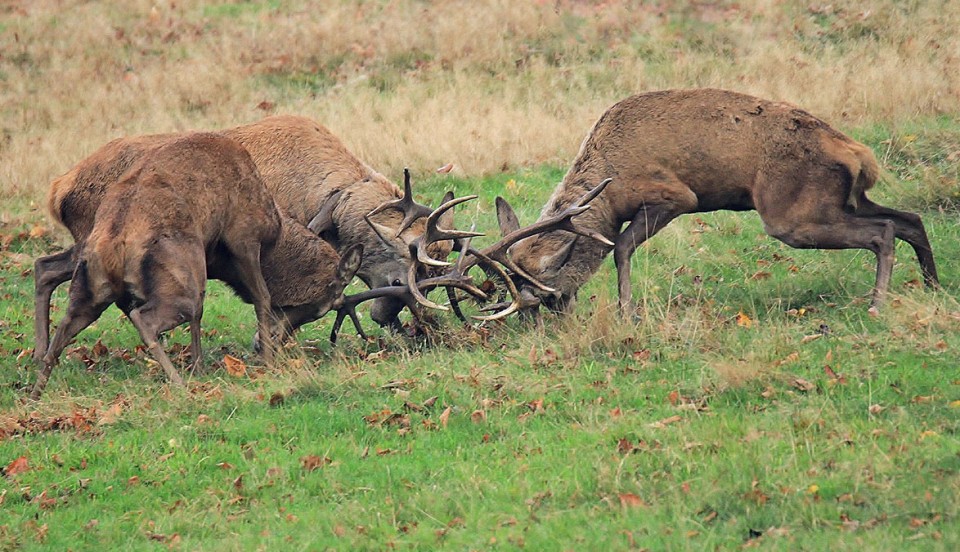
In some cases severe injuries are obtained, including damaged eyes, slashes or puncture wounds and even broken legs. On very rare occasions, two stags may get their antlers locked together and, if they cannot disentangle themselves, both are likely to die. There are also some instances where three stags are involved in a clash. The reason for three-way clashes among Red deer isn't fully understood, but similar behaviour has been documented in Fallow deer (Dama dama) and, in a 2011 paper to Animal Behaviour, Dómhnall Jennings and colleagues suggested bucks sometimes try and 'break up' clashing males because it makes them more attractive to the females (does); giving the impression they've "bested" two males at once.
It is worth noting that, although the norm, a stag does not have to have antlers to be involved in a clash and an eight year old hummel (male deer that doesn't grow antlers) was filmed fighting with a five year old antlered stag on the Scottish island of Rum in October 2017.
Something to shout, or bolve, about
The roaring of the stag (sometimes called "bolving") is an important, not to mention impressive and (when heard in pitch darkness) somewhat eerie, component of the rut. Roaring notifies other males of your presence and gives them an idea of your fitness – roaring is an energy-expensive activity, so those who roar at frequent intervals for prolonged periods must be relatively fit individuals. The acoustics of the roar is what biologists refer to as an ‘honest’ indicator of fitness, which means that it’s not something the animal can ‘fake’ because it is under physiological control.
If you think about your own voice, for example, you can make it higher pitched or deeper, but you can’t make it deeper than your physiology (i.e. the size and shape of your vocal tract) will allow. In the case of stags, a deeper louder roar signals a large animal. Of course, this information is not only of use to other stags -- who can decide whether or not to ‘try their luck’ from a safe distance -- it is also an honest signal to females, who use it to judge the best quality males in the area; work by Cambridge University biologist Karen McComb in the mid-1980s found that it may go even further than this.

In a letter to the journal Nature during 1987, McComb presented her data on the impact of roaring on hind reproductive state, which showed that the roaring of stags advanced the date of oestrus (i.e. caused the hinds to ovulate earlier) over the control groups that weren’t exposed to taped roars. McComb concluded that harem-holding males could improve their mating success by calling regularly.
In his book Scottish Red Deer and their Conservation, Pat Lowe noted that not only was he able to tell recognise stags based on their roaring, he also noticed a change in the vocalisation during the rut. Lowe explained:
"... each year there was the same sequence with loud, rich and clear bellows at the start followed by clear but broken roars at the peak, and ending with cracked or broken voices ending in a series of coughs rather than roars to end their rutting activities."
In Europe Red deer roar with a relatively deep and baritone in nature, while Red deer (Cervus canadensis) in North America produce a much higher pitched call often referred to as a "bugle".
Curiously, roaring is not only associated with stags; hinds are known to roar in the days leading to calving, which vet and deer biologist John Fletcher suggested may be a response to a flooding of the brain with oestrogen.

In most habitats, clashes between stags are less common than most realise and in forest environments the rut is often a quieter affair, with stags rarely uttering more than the occasional roar (especially on frosty nights/mornings) or, more commonly, just grunting. The frenetic activity that we see in the Scottish Highlands -- and to some extent in park situations, too -- is a result of the large open expanses of the grasslands. In forest habitats, tree cover prevents a harem-holding stag from seeing neighbours and he apparently finds it unnecessary to continually proclaim his harem-holding might. On the hillsides, it’s easier for the hinds to disperse more widely and the stag can see all the other stags in the vicinity and must therefore exert a terrific amount of energy trying to keep his hinds together and see off challenges from other males.
A Red deer (Cervus elaphus) stag roaring (bolving) during the rut in the UK. - Credit: Marc Baldwin
The high-pitched rutting call of North American Red deer (Cervus canadensis), aka the wapiti or elk. This call often ends with a "jerking cough" and is typically called a "bugle". - Credit: Rocky Mountain Elk Foundation
All this activity takes its toll on the stag, which may lose between one-fifth and one-third of its body weight during a fortnight of intensive activity; he must then retire to recover from what Richard Prior rather comically described as a "king-sized hangover". Consequently, as the rut advances, the harem-holding stags become progressively more exhausted and the likelihood of them being overthrown increases. The rutting season may last for six weeks or more, each stag will hold a harem for considerably less than this – from a few minutes to a couple of weeks. The 2015 series of the BBC’s Autumnwatch observed that the rut on Rum continued day and night, with roaring, parallel walking, clashing and rounding up of hinds filmed in pitch darkness.
Choosing your battles
It is interesting to note that some mature, experienced stags appear to convey some form of stability to the rut; this was demonstrated in exciting fashion on British television last year. During the 2009 rutting season on Rum, the long-standing ‘champion’ of the rut -- as proclaimed by the BBC’s AutumnWatch programme -- Percy (most, if not all the Rum deer have been named by the RDRG biologists) was defeated by the younger stag Cassius following a fight that lasted more than five minutes. It seems that Percy’s displacement triggered a coup d'état the likes of which the RDRG biologists had never seen. Many other stags emerged from the metaphorical ‘woodwork’ to challenge Cassius and during a period of a little over an hour, Cassius fought with each stag and won.
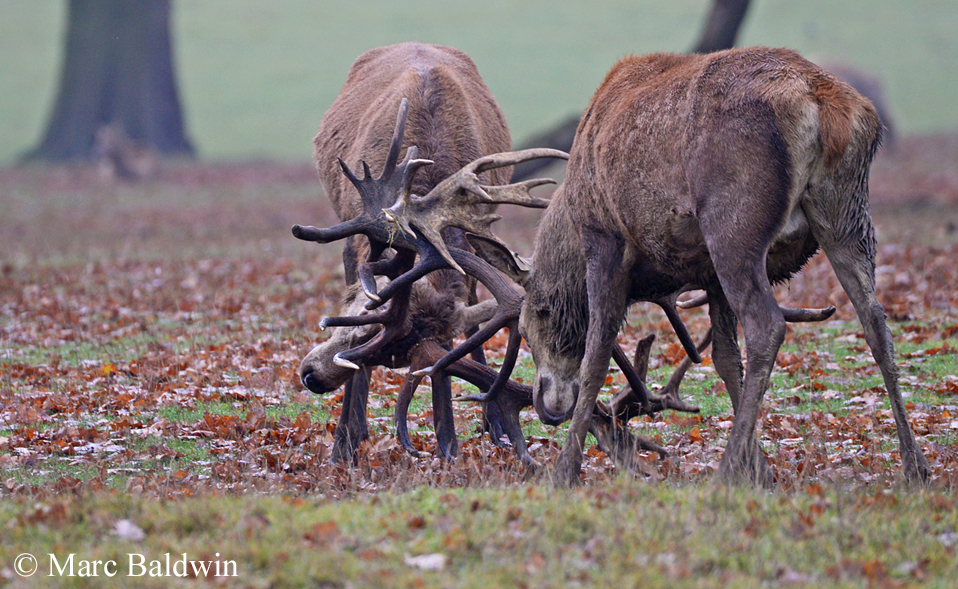
This situation provided a fascinating behavioural insight into the mating behaviour of Red deer and aptly demonstrates a crucial point: holding a harem is important. In a subsequent (2015) Autumnwatch, a stag was observed to wait until a harem holder had just won a fight with another male and was exhausted before charging in to overthrow him. They also filmed a one-antlered stag winning a clash against a male with two antlers and witnessed a stag continue with a clash for some five minutes after breaking one of his antlers close to the pedicle (base). Observations such as these serve to illustrate how strategy, determination and persistence are all important components of the Red deer rut.
Subordinate stags will often spar with each other and even some of the more mature individuals. Typically, these juveniles are testing their limits and practicing their technique for future ruts. Based on observations of Rum's Red deer by Tim Clutton-Brock and his colleagues, the frequency of sparring declines after the fifth year. During their study, sparring bouts were usually initiated by the dominant member of the pair and generally terminated by the subordinate.
The harem - eggs in a single basket
The biologists of the RDRG have established that a critical component to successful mating for Red deer is holding a harem; without one their chances of mating are low. The RDRG have demonstrated that, among the Rum deer, stags rarely hold substantial harems until they are six or seven years old. Indeed, on Rum hinds ran away from young stags and rejected mating attempts by stags younger than five years old at the peak of the rut. Harem size ranges from two-or-three hinds to as many as 70 and stags are most likely to hold them at between nine and 11 years old - few maintain them past the age of 11.
The ages of stags participating in the rut is also reflected in feeding studies, which illustrate how stags of different age groups use different breeding strategies. Biologists typically divide animals into either ‘capital’ or ‘income’ breeders, which basically means that they either rely on fat reserves during the breeding season (capital) or they rely on whatever food is available at the time (income). In habitats such as Rum, mature harem-holding stags are typically capital breeders; they don’t feed during the rut and survive on the fat reserves laid down during the spring and summer. Conversely, older and younger animals are income breeders who continue to feed during the breeding period because they’re less involved in challenging ‘prime’ males for mating rights. Consequently, it tends to hold that prime age males lose the most weight (relatively speaking), while both young and old individuals lose proportionately less. I should mention that, in my experience, this is not true of all populations, and in habitats where competition is low (e.g. in the New Forest at the time of writing) prime harem-holding stags may continue to feed throughout the rut.
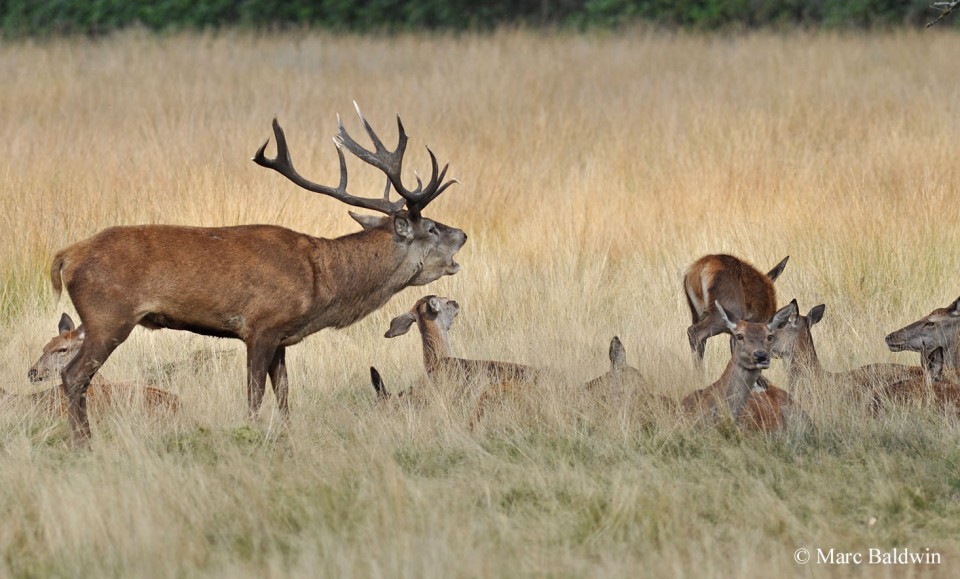
Of course, all this effort on the part of the stag is aimed at one goal: to mate with the greatest number of females possible, and pass as many of his genes on to the next generation as he can. Thus, if a stag can defend a group of hinds from the attentions of other males, he can mate with each hind as she comes into oestrus (season). As the hinds approach oestrus, the male becomes increasingly attentive and displays a behaviour known as flehmen, a phenomenon first described in Red deer by hunter and naturalist Jacques du Fouilloux in 1561. Flehmen is a German word meaning ‘to curl back the lip’ and involves the stag curling its top lip back to expose the vomeronasal organ (VNO) located in the top of the mouth. The VNO (or Jacob’s Organ) is a fleshy organ used to assess air currents and fluids for pheromones – this explains why the flehmen response is often associated with the stag sampling a hind’s urine.
Fit to breed? The importance of condition
Early studies of the Red deer on Rum failed to find any evidence of a "silent oestrus" -- where the hind undergoes a physiological oestrus, but no behavioural oestrous (in other words, she ovulates, but doesn't show any changes in behaviour like she does for her first proper, or "overt" oestrous) -- that is so well documented in livestock. The phenomenon has since become well established in deer, however, including Reds, and has led some biologists to speculate that a silent oestrus may be a trigger for the rut to get into "full swing". Regardless, studies by Claire Adam at the Rowett Research Institute during the mid-1980s have suggested that the trigger for the oestrous is a rise in melatonin (a hormone produced in the pituitary gland in response to shortening days), which leads to a change in both quantities of, and sensitivity to, progesterone and oestrogen in the hind's blood plasma.
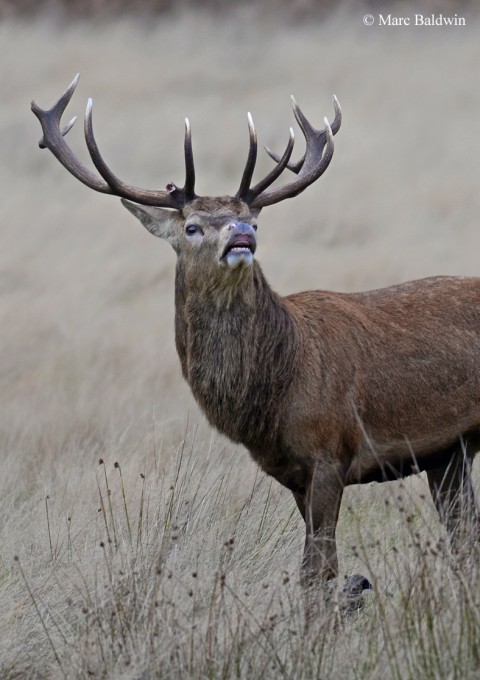
The precise hormonal mechanisms involved in stimulating oestrous in hinds are rather complex and require further study. To try and avoid unnecessary confusion (and extending this article by several pages.), I shall deem the topic out of the scope of this article, but in summary Adams and her team were able to show that by giving their captive deer supplements containing melatonin stags shed velvet and started rutting five weeks earlier than the un-treated animals. Similarly, hinds administered with melatonin started their first oestrous and ovulation in mid-September, five weeks earlier than those that weren't given the melatonin. The initiation of oestrous as a response to the nights drawing in is why deer are sometimes referred to as short day breeders.
The specific time at which the female reaches puberty and comes into oestrus depends largely on the environmental conditions and, specifically, the conditions in which the animal overwintered. In high-quality habitat (e.g., in deciduous forests and parks), hinds reach puberty at around 15 months old, although on the Scottish hillsides and Rum, puberty may not be attained until the animal is three years old. Studies on both farmed and wild deer suggest that there is a "critical" body weight that the hinds must reach if they are to successfully ovulate and stand a chance of conceiving. Consequently, hinds weighing less than about 50 kg (110 lbs) rarely calf.
Given that body condition (generally expressed in terms of body weight) is such a critical component to the hind's fertility, it is not unexpected that hinds wintering in good conditions enter oestrus earlier than those wintering in harsher conditions. Similarly, hinds living in good quality areas may be able to re-gain sufficient weight after having calved to produce a calf every year, while those in poorer habitats (such as on Rum) may only breed every other year. Indeed, Tim Clutton-Brock and his colleagues at Cambridge University have demonstrated that the hinds on Rum that successfully raise a calf in a given year -- these are referred to as milk hinds because they have borne the costs of lactation -- often fail to put on sufficient weight by the onset of winter and are more likely to die than those that haven't calved (so-called yeld hinds, from the old English gelde meaning "barren").
The Rum biologists estimate that about 35% of these milk hinds fail to breed in the following year and the majority of hinds in the Scottish Highlands breed in alternate years. As can be imagined, population density also has a considerable influence on the condition of the hind; more deer equates to less food per animal and a lower probability of reaching "critical weight" in time to breed. Thus, increasing populations typically lead to reduced breeding success and low calf survival.
Oestrous and mating
Prior to the initiation of the Rum long-term study, little was known about the reproductive biology of deer. This changed in 1971 when RDRG biologists Fiona Guinness, Gerald Lincoln and Roger Short presented their data, in a paper to the Journal of Reproductive Fertility, on the reproductive physiology and behaviour of Red deer hinds that were caught on Rum as calves and hand-reared. From this study, it was established that hinds came into oestrus during the second week of October; the hind is then receptive for around 24 hours every 18 days-or-so until February or March, or until she conceives. The biologists noted that, just prior to starting oestrus, the hinds developed a "sweet, musty smell around the tail" and a "second, strong penetrating odour coming from the vaginal mucus". Apparently, at the start of oestrus clear fluid mucus could be seen dripping from the vagina and tail, which became increasingly cloudy and viscous as the rut progressed.

A hind will be in oestrus for only about six hours per cycle and, as the time approaches, the stag will remain within a few metres of her and become very attentive. Initially she may shun the stag's advances, but as she comes into season she may solicit the stag by trotting past with her head held low and neck extended making a characteristic open-mouthed chewing action. The stag will follow and, in some cases the act of mating may be preceded by a brief chase. When the hind is ready, she will stand still in front of the stag with her back slightly arched, her ears back and her tail raised, at which cue the stag will mount her. In their 1971 paper, Guinness and her colleagues wrote of the mating:
"After mounting, the stag would pause momentarily to achieve intromission [penetration]. Then, after a few mild pelvic thrusts, he would lunge violently upwards from his hind quarters so that his legs left the ground and his body assumed an almost vertical position. The force of his ejaculatory thrust usually pushed the hind forward a few paces, and the stag dismounted in the process."
A similar description of the mating procedure is given by John Fletcher (who worked with Guinness and her team in the late 1960s and early 1970s) in his fascinating book A Life for Deer, in which he wrote:
"Eventually, late in the rut, the hinds will stand, and after some nervous clumsy attempts the stag will rapidly come to ejaculation, and presumably orgasm, and with one colossal thrust lifts all his four legs off the ground and push the hind forwards."

The hind will continue to ovulate every 18 days until she is successfully mated and Fletcher goes on to mention how the intensity of the hind's oestrous behaviour grows with each successive cycle: at the start of October, the oestrus is barely perceptible to the human observer but, come December, if she hasn't been mated, the hind is "rampant with overt urge to be mated and solicits the stag shamelessly2. Fletcher doesn't give specifics, although, in December 2024, Jochen Langbein filmed a red hind repeatedly circle a stag at Ashton Court park in Bristol. She periodically rubbed her head on his, despite him showing little interest and repeatedly turning away. After a minute or so of this, the stag mounted the hind, after which she returned to the herd.
In their 1971 study, Guinness and her team noted that when hinds were prevented from becoming pregnant, some continued to come into oestrus every 21 days or so until March, undergoing as many as eight cycles. Similarly, Dave Webb of the South West Deer Rescue and Centre in Devon has filmed rutting behaviour in their Red deer herd during December and January and stalkers occasionally report Red deer roaring and chasing hinds in the Scottish Highlands during December. (Camera-trap studies by deer biologist David Dixon has demonstrated a similar protraction of the rut in Fallow.)
Once successful copulation had been completed, the biologists observed that the stag often stood, roared and urinated, while the female either stood for a few minutes with her back arched and ears flat straining her abdominal muscles, urinating and defecating, or she would resume grazing. Following ejaculation, the stag wouldn’t attempt to mate again for at least another 20 or 30 minutes. Cervus elaphus is a polyandrous and polygynous species, meaning that neither sex show any monogamy, although they may mate with the same partners on several occasions. In some instances, a hind may be mated by several different stags during a single oestrus, but it seems that many will mate only once per oestrus. Data provided to the 2015 series of Autumnwatch by the RDRG suggest that 80% of Red calves born on Rum are fathered by about 20% of the stags. Similarly, unpublished DNA sampling by the RDRG at Kilmory suggests that the largest stags, although big and impressive, are substantially less effective at covering hinds as the younger males (i.e. 8-10 pointers) owing to the amount of time they spend chasing and fighting.

Whether a hind becomes pregnant depends upon the conditions: in areas of low deer density (where there is more food per head) between 25% and 67% of the yearlings can become pregnant, while in the favourable conditions offered by many lowland deer parks the yearling pregnancy rate can be 90% or higher. There also appears to be a considerable synchronicity of conception; in his 1999 book Kia: A Study of Red Deer, Ian Alcock points out that:
“... around 75% of wild red deer hinds [presumably on Rum] conceive within about a three-week period at the end of October.”
Pregnancy: Gestation and birthing
Work in Scotland and elsewhere has demonstrated that most hinds (up to 85%) conceive during their first oestrus, if successfully mated. Gestation lasts for between 225 and 245 days (7.5 to 8 months) and in the 1971 Rum study, the average was 231 days. The gestation length varies considerably among the proposed subspecies of deer and some fascinating crossbreeding studies have revealed that hinds gestating hybrid foetuses have gestation periods intermediate between the two parent subspecies. Such results fostered the notion that the length of gestation in Red deer was genetically fixed, within narrow limits. Recent work by a team of New Zealand biologists, headed up by Geoff Asher, and a team from Spain’s Universidad de Castilla-La Mancha, fronted by Andres Jose Garcia, have uncovered compelling evidence to the contrary, however.

The studies have shown that both nutritional state and date of conception can affect the length of the gestation. Hinds conceiving early in the season tended to have longer gestation periods than those conceiving later – Garcia and his team proposed that this may help reduce the likelihood of out-of-season births. Similarly, Asher and his colleagues have found that well fed hinds had shorter gestations than those on a lower quality, or restricted, diet – the quality of the nutrition seems to be most important during the third trimester of pregnancy, during which the developing calf puts on the most weight. The biologists speculated that it may be desirable for hinds to devote the effort to ensuring that a fully developed calf is born, even with the added expense of a longer gestation. There is also some evidence to suggest that pregnant hinds which fail to reach the necessary condition early in the rut may resorb the foetus.
Thus, overall, it seems that nutritional state (especially late in gestation) is probably a more significant driver of protracted gestation than the date of initial conception, but more work is needed to clarify the relationship.
During the latter part of pregnancy, the hinds tend to spend much of their time resting; in captivity, they may be seen pacing the fences more than at other times of the year. In some instances, increased aggression has been documented just prior to giving birth, while others have recorded bellowing in a similar manner to a stag during the rut. Indeed, in his A Life for Deer, John Fletcher tells of how hinds “roar like stags in the few days prior to parturition” and he suggests that by this stage the hind’s progesterone (the hormone that gets the womb ready for, and maintains it during, pregnancy) levels have fallen, exposing her brain to the full force of oestrogen. Fletcher’s Ph.D. work on the Red deer of Rum showed that oestrogen mimics testosterone, acting to stimulate roaring in both sexes.
Preparing for the delivery
When the hind is ready to give birth, she will leave the main herd and move to an area peripheral to her normal range (i.e. where she spends most her time) to give birth in isolation – a hind may calve in the same general area over successive years, but it is apparently rare for the exact same site to be used more than once. The hind may leave the herd at any point from a couple of days to a couple of hours before parturition; in a paper to the journal Behaviour during 1975, Tim Clutton-Brock and Fiona Guinness report that, on Rum, the hinds usually left their matriarchal group between two and 12 hours prior to calving.

A team of biologists headed up by Tim Birtles, the operations director of Tatton Park in Cheshire, has documented the calf site selection by Red deer in two deer parks and a deer farm in north-west England. The results of the study, published in the journal Animal Welfare during 1998, show that “areas of obvious plant cover were selected in preference to open ground” and although this did vary with the habitat, the biologists concluded that “cover appeared to be a primary requirement for calving”. Similar data have been obtained from wild deer and the RDRG have also noted that hinds on Rum tended to move to higher ground, where deer densities are lower, just prior to calving and remain there until the calf was old enough to join the herd (around two weeks old).
Shortly before parturition there is a noticeable swelling of the hind’s udders and vulva. In two papers to the Journal of Reproduction, Fertility and Development during the mid-to-late 1970s, Pamela Arman at Aberdeen’s Rowatt Research Institute and her colleagues described in detail the calving and maternal behaviour of penned and free-ranging (farmed) tame Red deer. In the penned deer, Arman found that labour lasted around 40 minutes, from the appearance of the amniotic sac to the birth of the calf – during labour the animals were restless, standing up and lying down alternately. Arman witnessed three births during which two hinds calved standing up, and the third lying down.
Parturition
Arman, along with two colleagues, subsequently described the calving of 27 free-ranging farmed deer, among which parturition lasted an average of 1 hour 47 minutes, with the placenta being released just over 1 hour 30 minutes after calving. In 79% instances, the hind gave birth lying down and in 88% cases, presentation of the calf was normal (i.e. front feet first, then the head); only one calf was abandoned when the hind was disturbed by a keeper bringing the morning feed.
From the observations of Arman and her colleagues it appears that the hinds are primarily attracted to the smell of the placenta and afterbirth, which they immediately eat (presumably as an anti-predator mechanism), even at the expense of the calf. In one case, a hind in the free-ranging group was seen to stagger into a stream where she dropped the calf before stepping out to clean-up the fluids; the authors wrote that the calf “would have become chilled and drowned but for rescue by the observer”. On Rum, the new mothers (called “dams”) have been observed to eat the afterbirth, placenta and any grass stained where it fell.
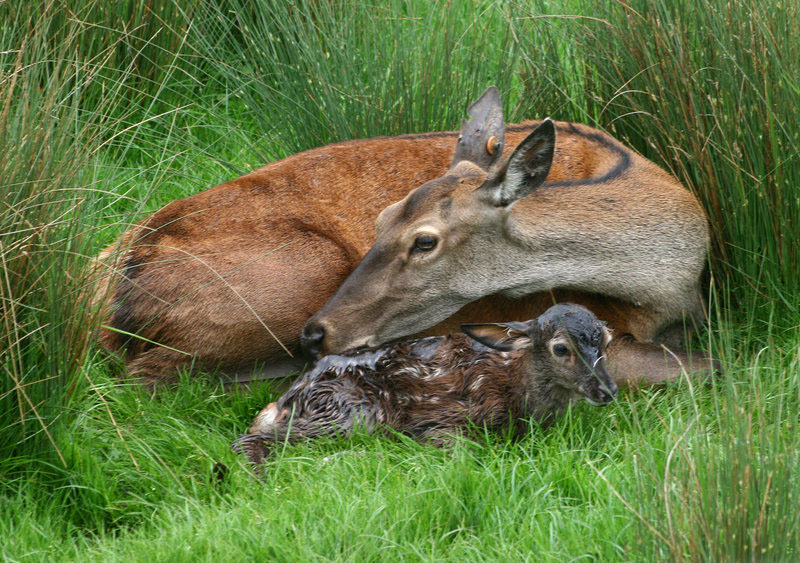
Typically, Red deer give birth to a single calf; twins are rare. In his A Life for Deer, John Fletcher notes that under conditions of plenty (e.g. in a deer farm or managed deer park), as many as 1% (1 in 100) of the hinds may give birth to twins, while only about 0.1% (1 in 1,000) of Scottish hillside hinds have twins. As with conception, birth times appear to be highly synchronised and during a study of hinds at Kilmory Glen (Rum) during 1974, Tim Clutton-Brock and Fiona Guinness found that nearly 70% calved in the three weeks between 25th May and 14th June, with just over one-quarter of all births taking place in the week of 1st to 7th June.
The Rum findings are in line with other studies, which have found that Red deer in the northern hemisphere have a short calving season, running from late May until mid-June, with most births taking place during the first and second week of June. There have, however, been reports of fully developed foeti in December and calvings as early (late?) as January. Indeed, a hind at Snettisham Deer Park in Norfolk gave birth to a calf in October 2015, and there was a record of a Red deer calf born in County Donegal in Ireland on 22nd November 2016. On Exmoor, in west Devon, Jochen Langbein has recently received reports, along with photographic or trailcam evidence, of calves being born as late as mid- or even late September. Langbein has mused upon whether the warmer/drier springs and milder winters that we appear to be experiencing as our climate changes might account for hinds breeding later into the year and hence giving birth well into autumn.
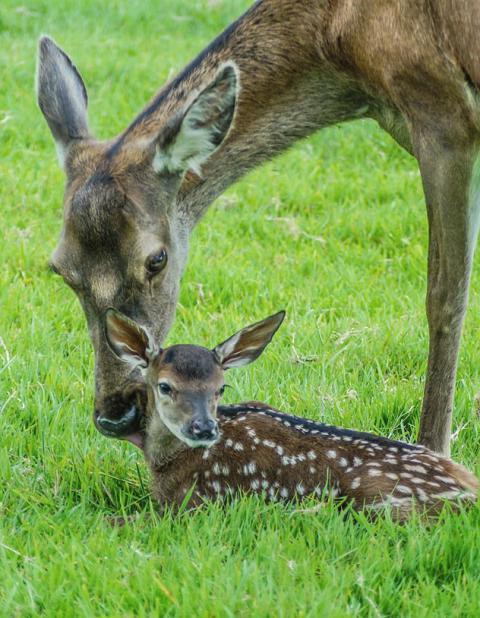
Growth and development of calves
The weight of the calf at birth varies according to the habitat, condition of the mother and the sex of the calf. Ms Arman and her colleagues reported male calves with a mean weight of just over 6.5 kg (just under 14.5 lbs), while female calves averaged 6 kg (weights were once the calf was dry and had suckled for the first time). Birth weights reported elsewhere in the literature range from 6 kg to 11 kg (24 lbs). On Rum, the RDRG have found that the birth weight of calves was closely related to the average daily temperature during April and May – when temperatures were higher (i.e. between 9 C and 10 C; 48 - 50 F) birth weights were higher than in years when the temperature was between 6.5 C and 7.5 C (44 – 46 F), presumably because grass growth is advanced by warm springs. It seems that, on Rum at least, although population density can influence birth weight (with smaller calves being born when deer numbers are high), the climate exerts a stronger influence.
Taking the Kilmory and captive data in concert, we can construct a reasonable postnatal timeline of the behaviour of the dam and her calf. The captive observations showed that the first suckling took place after about half-an-hour, while the hind was lying down, and lasted between 45 seconds and four minutes, during which time the calf took between 150 mL and 600 mL of milk; the calves could stand within about 45 minutes of birth. Clutton-Brock and Guinness noted that, in the first few hours following birth, the hinds remained within about 50 m (164 ft.) of their calves, after which they spent much of their time more than 100 m (328 ft.) away – some were observed feeding more than a kilometre (just over half-a-mile) away from their calves. The biologists also found that the hinds were more frequently alerted while feeding away from a hidden calf (i.e. they were more ‘wary’); if accompanied by a calf less than 21 days (three weeks) old, they increased their ‘circle of fear’ (i.e. the observers couldn’t get as close as they could before the calf was born).
It seems that when the calf was more than 21 days old, the hinds returned to their pre-calving level of alertness; hinds were also less wary when their calves were lying down than when they were standing up. The calves are born with their hooves enclosed in yellow cartilage (sometimes referred to as ‘golden slippers’), which protect the mother’s womb and wear away during the first couple of days following birth.
Keeping a low profile: lying-up behaviour in newborn deer
The notion that it is perfectly normal behaviour for the dam to leave her calf in a suitable ‘hiding place’ (typically an area of long grass, or woodland cover) while she moves off to feed is important to recognise. There are countless examples each year of people ‘rescuing’ a deer calf that they have found lying on its own, believing it to have been abandoned by its mother. There is little doubt that some calves are orphaned (especially in areas where deer are at risk from predators) or abandoned by their mother; the latter of these seems most likely soon after birth, before the calf can suckle and death is usually rapid. In her book Deer, however, Norma Chapman points out that true deer orphans are very rare.
Rather ironically, a person acting in what they assume is the best interest of the calf may actually cause it to be abandoned; the dam may reject the calf if it carries the scent of a human. The advice from the major animal welfare charities and deer biologists alike is, if you find a calf lying on its own, unless it appears in need of veterinary attention, leave it where it is and do not attempt to touch it – the mother will be somewhere nearby. Indeed, the mother will return to feed the calf periodically.
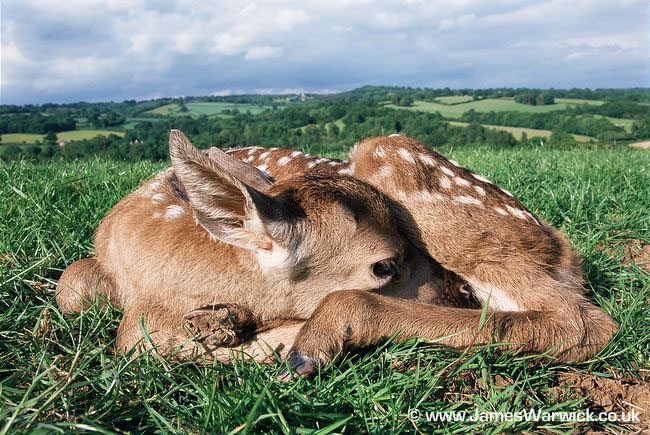
It should be noted that calves choose their ‘hiding spots’ carefully, generally opting for long vegetation in sheltered spots and often on raised ground when very young. The RDRG found that, as the calves grew older they were more frequently found lying on the short grass of the greens, at sites where they weren’t sheltered or raised. The calf remains in one of its various hiding spots until late September or early October, when the longer hairs of the winter coat starts to grow. The hind pays close attention to her calf’s the choice of hiding spot. In his 1999 book, Ian Alcock noted that Kia (a hind in his care) called to Juno (her calf), lying nearby, periodically with a “squeaky grunt” that was clearly loud enough to be heard by the author at about 200 yards (600 ft) away. (See Behaviour & Social Structure for more on mother-calf communication.)
Clutton-Brock and Guinness noted that most of the hinds made daily trips away from their calves to feed, returning two or four times per day to suckle them (the calf may be suckled five to ten times per day). Stag calves are suckled more frequently than hind calves, although there is also a close relationship with the vegetation quality – in areas where forage quality is poor the calves are suckled less often. A series of experiments on deer imported to Mexico from New Zealand have provided an insight into suckling frequency under conditions of plentiful food.
Milk composition and calf suckling
A team of biologists at the Universidad Nacional Autonoma de Mexico found that the calves suckled more frequently as they got older, although the average time spent ‘per suckle’ declined. Some of the calves started eating solid food (in the form of cut grass mix put into their pens) at about eight days old, although they didn’t start ruminating until they were around 20 days old. Similar data have been gathered from wild deer, showing that within the first few weeks of life, a calf will suckle around six times per day, declining to three times or fewer per day by the time the calf is two months old. Interestingly, however, data from wild deer suggest that the lower frequency of suckling events is counterbalanced by longer durations of suckling (i.e. the calves suckle less often, but spend longer per suckle); presumably the confinement of captivity makes it easier for the calves to suckle ‘little and often’.
During the Mexican study the researchers observed allosuckling, where a dam allowed a calf that wasn’t her own to suckle from her and, at one point, 14 out of the 20 hinds in their herd were nursing calves that weren’t theirs. In all cases, the allosuckling bouts were less frequent and shorter in duration than filial nursing (i.e. mother nursing her own calf). The dam will lick the urogenital opening of the calf as it suckles, to stimulate it to empty its bowels; she then eats the faeces and urine.
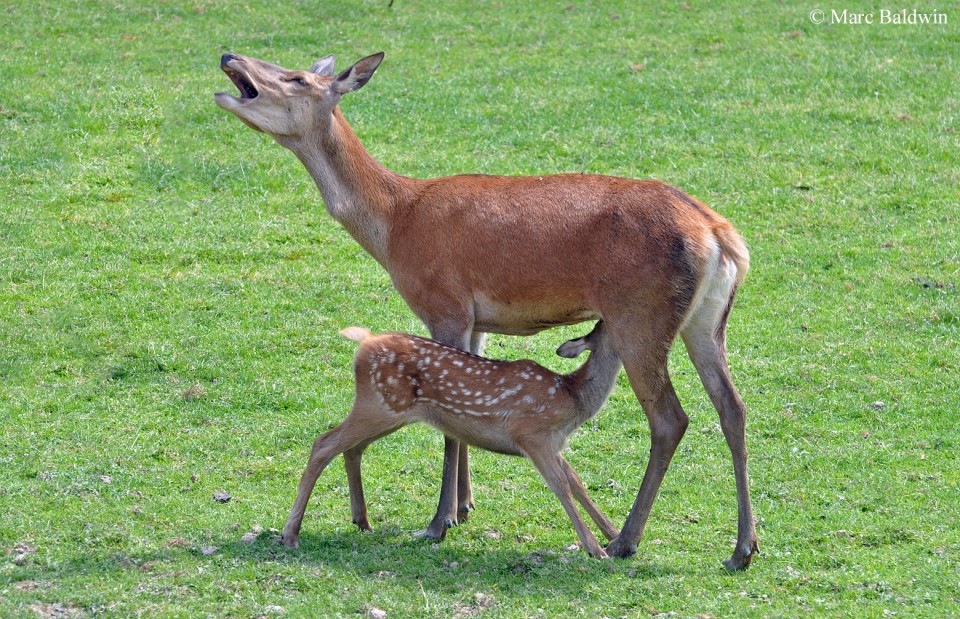
Having access to sufficient milk, and milk of a suitable quality, is crucially important for the developing calf. Milk yield and quality seems to be dependent upon the hind’s condition and, according to recent work on captive deer in Spain, the subspecies of the deer in question. It transpires that Scottish hinds (Cervus elaphus scoticus) are not only larger than their Iberian (C. e. hispanicus) counterparts, but also drop heavier calves that grow more rapidly on a diet of milk that is richer in protein.
In 1975, Pamela Arman and three colleagues from the Rowett Research Institute in Aberdeen published a paper in the Journal of Reproduction and Fertility, in which they documented the components and yields of Red deer milk. The researchers found that well-fed hinds could produce up to two kilos (just under 4.5 lbs) of milk per day during early lactation; the lactation period varied from 190 days (just under 7 months) to more than 280 days (10 months). The total yield during the first 150 days (5.5 months) was estimated to be between 140 kg and 180 kg (309 – 397 lbs) in the well-fed hinds and 65 kg (143 lbs) in an underfed hind.
Arman and her colleagues found the red deer milk to be very rich and noted that the composition changed as lactation progressed. As the calf grew, the fat content increased from around 7% close to the start of lactation to 13% 140 days in, while the protein increased slowly from 7% to 9% over a period of about 180 days. The increase in solids with progressing lactation led to a marked increase in the energy value of the milk. The biologists also found fairly high levels of calcium and phosphorous (important bone-growing nutrients) in the milk; their data also point to a rapid replacement of colostrum (the first milk produced, high in fat and white blood cells) with normal milk, complete by the third day of lactation.
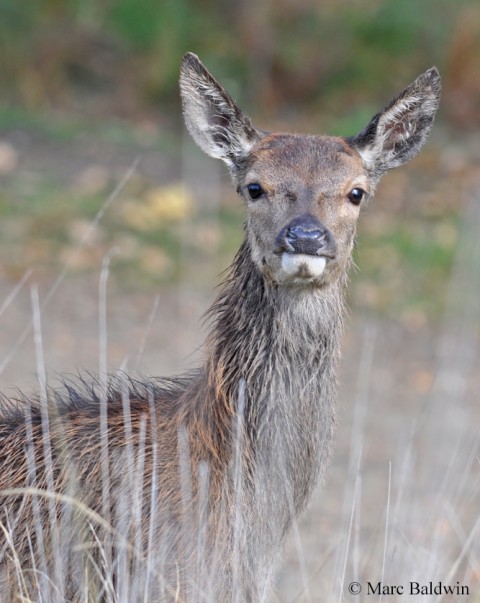
In 1987, R.M.F.S. Sadlier wrote of how deer typically produce milk from the food ingested on the day, rather than mobilising body reserves. This fits in well with observations from Rum and elsewhere that lactating hinds tend to seek out grazing areas offering the highest protein content, because protein is crucial to the growth and development of the calf. Indeed, there are several studies that show how, if a hind fails to maintain sufficient protein content in her milk, her calf suffers reduced growth, which can have a dramatic influence on its survival. Indeed, in their 1982 book, Red Deer – Behaviour and Ecology of Two Sexes, Clutton-Brock, Guinness and Albon write:
“The growth rate of calves during the first six months of life is probably the principal determinant of the size at which they enter winter and is likely to affect both their chances of survival and their body size as adults.”
As lactation wears on, the calf becomes less interested in suckling and the hind typically seems less patient during periods of suckling; some authors report the hind walking away mid-suckle. The calf is suckled for six to ten months (they are typically weaned by about eight months old) and is usually independent by the time it’s a year old, although data from Rum has shown that, if the hind fails to conceive during the following rut, she may continue to suckle the youngster until it is a year-or-so old. Observations on captive deer have documented calves eating soil, which some have suggested is a way for the calves to obtain their gut microbes, while others point to a possible mineral deficiency.
The calf may begin to follow its mother at between seven and 10 days old and as the hinds return to their normal feeding grounds, the calves may form crèches. On Rum, the RDRG have found that the calf is generally seen within 10 metres (33 ft) of its mother but in their 1982 book Clutton-Brock and his colleagues note that it was “unsafe to assume that the hind closest to a calf was necessarily its mother.” Parental care is entirely maternal and the hind receives no paternal input during either gestation or suckling.
Sex ratio of calves
Much deer research on Rum has focused on the sex ratio of calves, because it reveals some interesting features of deer population biology. As we have seen, stag calves tend to be born heavier than hind calves; they also grow more rapidly, which means they require more milk and this puts a greater strain on the dam than a hind calf would. The more rapid growth rate of stags means that they’re more sensitive than hinds to food shortages. We shall see later on (see Behaviour & Sociality) that there is a marked, almost linear, social hierarchy within deer herds – in other words, there’s a pecking order with a hind at the top, one at the bottom and the rest arranged in between.
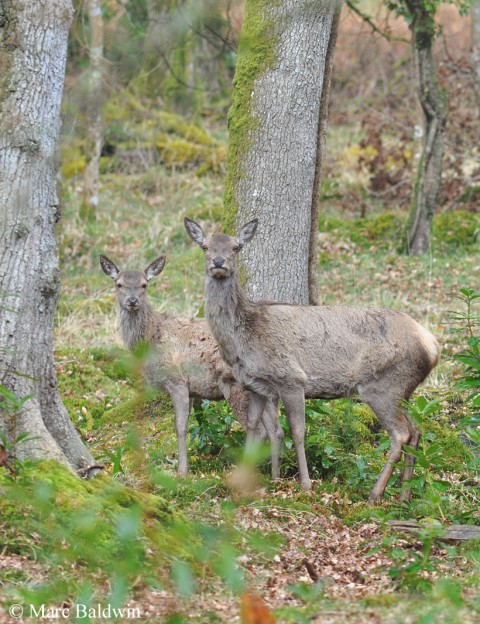
A consequence of this hierarchy is that dominant animals tend to have access to more food and food of a better quality than lower ranking individuals, which leads to dominant animals generally being larger and in better condition come the rut. The years of uninterrupted study of the Red deer on Rum has allowed the RDRG to observe that high ranking hinds tend to have more sons than lower-ranking females. The sons of dominant hinds also tend to be more successful (i.e. hold larger harems and sire more offspring) than stags born to low-ranking hinds – this is because the dominant hinds are better able to meet the energetic demands of the growing stag, while lower-ranking hinds generally produce weaker sons. Overall, the trend that the RDRG have observed is for females that produce stags rather than hinds to be more likely to die during the following winter (because they’ve not had chance to put the fat back on following lactation) and, even if they survive, they’re less likely to successfully rear a calf next year. Indeed, the RDRG have established that hinds producing male calves come back into oestrus, on average, 11 days later than dams that produced a female calf the previous year.
Purely in terms of genetics, a mother is better off producing sons if she can ‘afford’ to and there are two primary reasons for this: first males tend to disperse sooner and further than females, so they don’t hang around, adding pressure to the local food resources; and secondly, males can potentially sire more offspring than females can and thus the mother’s genes have a better chance of making it into subsequent generations. As we have seen, this seems to be the case with Red deer…to a point.
In a fascinating paper to the journal Nature more than a decade ago (1999) some of the RDRG biologists presented their data on how population density affects the sex ratio of these deer. The authors, led by Loeske Kruuk at Edinburgh University, found that as the number of deer in the population rose, even dominant hinds were less likely to produce stags; they also observed that as winter rainfall (i.e. that between November and January) increased, so the likelihood of a hind producing a stag calf decreased. Similarly, the biologists found that hind fecundity (i.e. how likely she is to produce a calf) declined as the population density increased and with increasing winter rainfall. Why should this be?
The answer lies in simple economics: more deer per unit area means less food per deer and higher rainfall is not conducive to good grass yield. Consequently, both factors impose what biologists call “nutritional stress” on the deer. Even under such nutritional stress, the previous observation that dominant hinds are more fecund than subordinates held and the biologists wrote:
“... dominant females were consistently more likely to calve in a given year than subordinates, but at low densities the sex ratio of their offspring differed.”
In other words, at high densities both dominant and subordinate hinds tended to produce female calves, while at low densities the dominant hinds had more stag calves, while the subordinates still had more hind calves. The relationship between fecundity and population density came as no surprise to the biologists, because previous work by the RDRG has shown that, although the time of mating isn’t dependent upon social status, the function of the corpus luteum appears to be, with the effect of breeding being suppressed in low-ranking hinds.
Over the hill? Red deer senescence
I have touched on the theory of the ‘disposable soma’ earlier in this article and although I don’t wish to delve too deeply into it, I feel it should be mentioned briefly here. The theory goes that breeding is an energetically costly exercise and diverts resources that would otherwise be used for repairing and replacing damaged and worn out cells elsewhere in the body. The result, as a team of RDRG biologists fronted by Cambridge University scientist Daniel Nussey has discovered recently, is that females that start breeding earlier show signs of reproductive senescence earlier than those that have their first calf later in life. In other words, hinds that are ‘past their prime’ (and this prime is reached earlier in early breeders) may continue to breed, but their calves tend to be smaller, weaker and less likely to survive than the calves born to younger females.

The biologists have also found that hinds born in hard times (i.e. when competition for food is high) senesce faster than those born in times of plenty. As Nussey and his colleagues put it in their paper to Current Biology in 2007:
“A female’s probability of producing a calf in a given year declined more rapidly in old age amongst females that experienced harsh early environments.”
Stags also show a decline in fecundity beyond about 10 years old, at which point they show reduced breeding success, holding fewer and smaller harems and ultimately siring fewer calves. This reproductive senescence is more pronounced in stags than hinds. Overall, the pattern is that, on Rum at least, the average hind raises four calves during her lifetime (although some won’t raise any, while others may raise as many as 13), while the average stag sires six offspring (ranging from zero to 24). In captivity, some deer have continued to produce calves (albeit at a much-reduced rate) up until 19 years old, when there is apparently a cessation in reproduction, even if the hind lives for longer.
Keeping it in the family: Inbreeding
The final aspect to consider before leaving the subject of reproduction is that of inbreeding. In evolutionary terms, inbreeding (that is, breeding with a family member) is typically a poor survival strategy, because it reduces the potential for ‘fresh blood’ (more specifically fresh genes) entering the gene pool and makes it less likely that the offspring will be able to cope with environmental changes. In some cases, this lack of genetic variability (geneticists call such genetic variability “heterosis” or “hybrid vigour”) can also lead to problematic genes -- those that code for diseases, for example -- building up in the gene pool, which can prove debilitating, if not fatal. So, breeding with those outside of your family (known as “outbreeding”, for obvious reasons) typically allows for a more diverse gene pool and this is good – there are, incidentally, examples of where this isn’t true (type “outbreeding depression” into your favourite search engine, if you’re interested), but that need not concern us here.
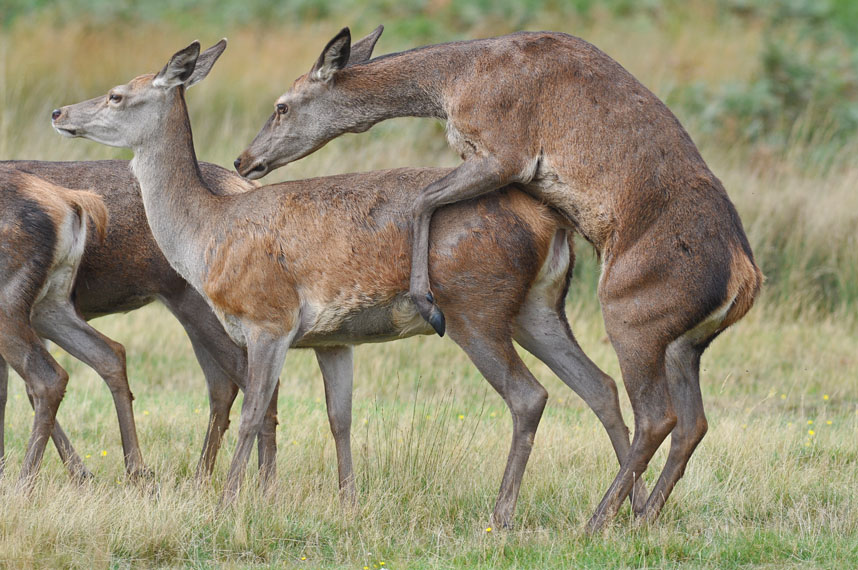
The details of this subject are outside the scope of this article, but it’s fair to say that the genetic inheritance a deer receives from its parents is important. Work by Josephine Pemberton and RDRG colleagues during the mid-to-late 1980s has established that the combination of genes a calf carries in its genome (genetic ‘blueprint’) can determine how likely it is to survive; some combinations benefit stags, while others benefit hinds. It also affects their long-term breeding performance and in a 2000 paper to the Proceedings of the Royal Society of London, some of the RDRG biologists report that outbred deer had greater ‘lifetime breeding success’ -- i.e. sired/raised more calves -- than their inbred counterparts.
‘Will a stag breed with his mothers, sisters and/or daughters?’ is probably a question fairly often asked of deer biologists. It is certainly true that rutting stands tend to be used year-on-year and that hierarchical relationships within female groups are fairly stable. If we couple this with the observations that hinds show a high degree of natal philopatry (i.e. they tend not to move far from their birthplace) it is not difficult to see how a stag could end up mating with his relatives and, as we have seen above, this does sometimes happen. Genetic analysis of the Rum deer using repeating sections of DNA called microsatellites has revealed, however, that close inbreeding -- i.e. mating with mothers, sisters and daughters -- is relatively rare among these deer, suggesting that there is reasonable mixing of populations on the island. Further weight is added because the biologists who conducted the study were unable to assess paternity (i.e. identify the father) in 35% of cases, which ties in nicely with the fact that at least 35% of stags are known to immigrate into their study area (North Block) solely for the rut.
Some observers have pointed to incestuous interest in calves at an early age, with reports of yearling animals trying to mount their mother. This is not an uncommon behaviour and a study of Red deer calves in the Czech Republic observed mounting behaviour in 21 calves (10 male, 11 female); half of which occurred when the calves were between 15 and 35 days old. In all but one mounting, when an overzealous calf mounted an un-related hind, the hinds casually ignored the attention. The reason for the behaviour is unknown. The Czech study found that it was often done just prior to suckling, but other suggestions include that it helps strengthen the bond, particularly if associated with situations where the youngster may be stressed/nervous, it may be practice for future breeding, or it could just be play.
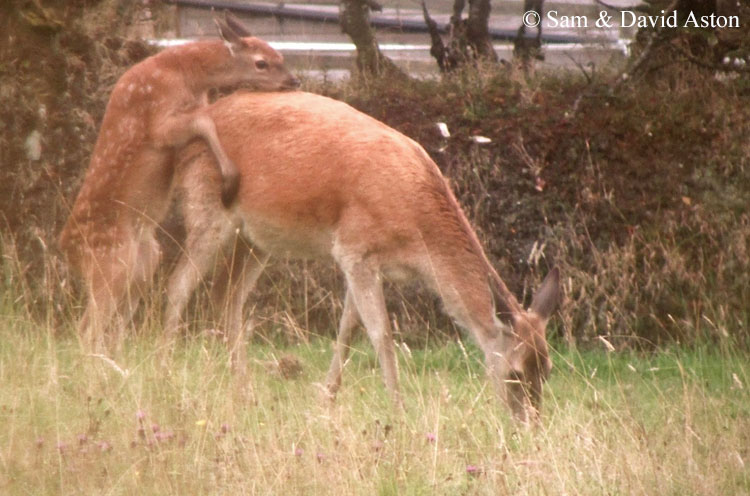
Hinds may also mount other hinds in the harem or social groups, the reason for which is also unknown but may be a subservient action. Hinds have also been observed mounting stags, almost as if signalling their readiness to mate to an ignorant harem-owner!
Overall, the genetic work on the Rum Red deer has shown that there is relatively high mixing between populations, with stags and hinds being drawn to the rutting stands every autumn. The RDRG have also established that few calves are fathered by males using what they refer to as “sneaky” strategies; even though young males may gather in the vicinity of an established harem and try to herd them away, it seems that the hinds avoid mating with these kleptogamists.